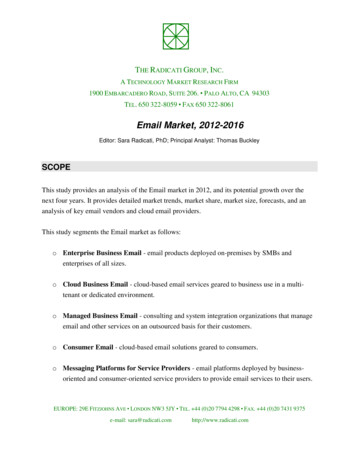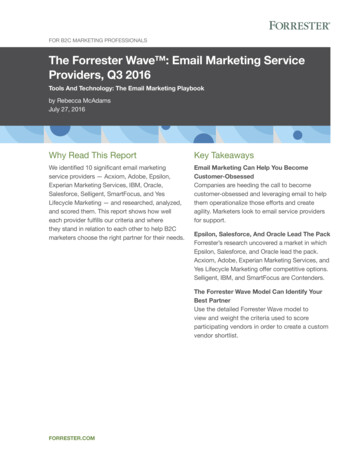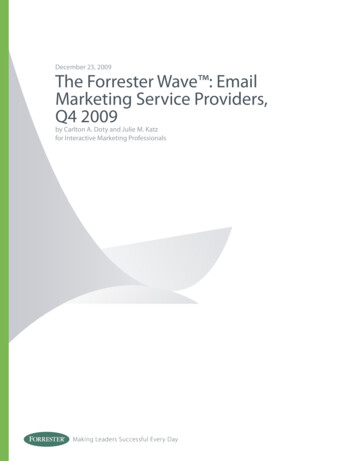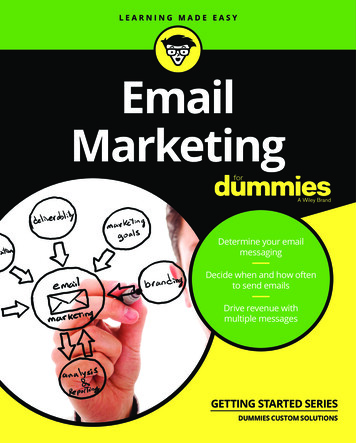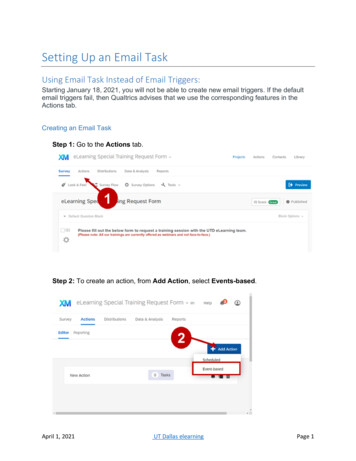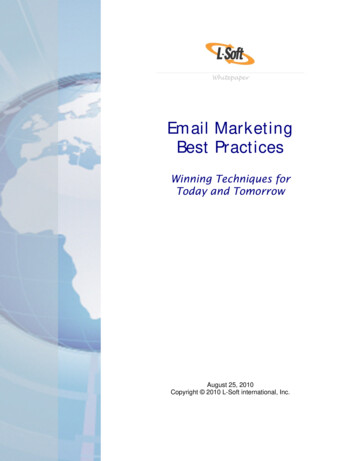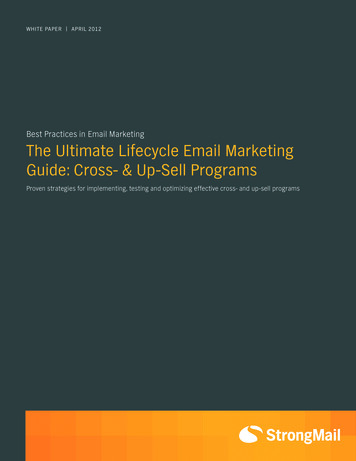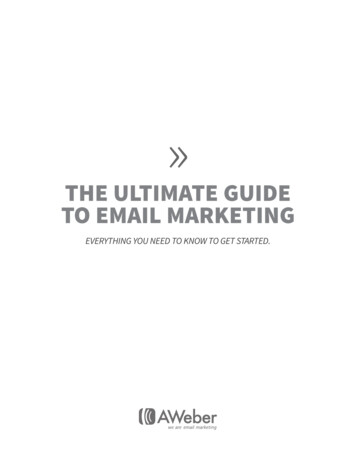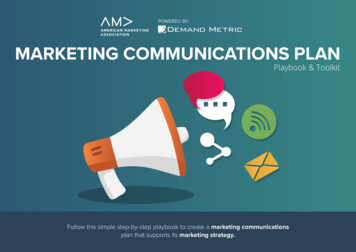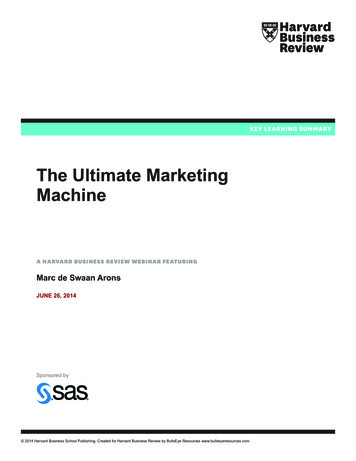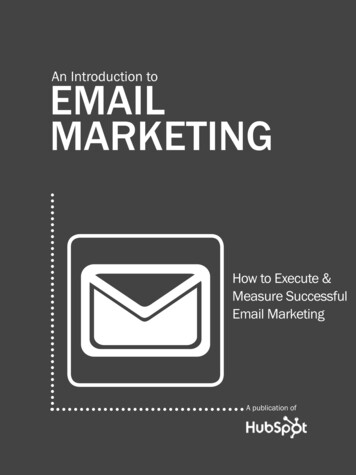
Transcription
1An introduction to email MarketingAn Introduction toEMAILMARKETINGHow to Execute &Measure SuccessfulEmail MarketingA publication ofShare This Ebook!www.Hubspot.com
2An introduction to email MarketingIS THIS BOOK RIGHT FOR ME?Not quite sure if this ebook is right for you? See the below description to determine ifyour level matches the content you are about to read.INTRODUCTORYThis ebook!Introductory content is for marketers who are new to the subject.This content typically includes step-by-step instructions on howto get started with this aspect of inbound marketing and learn itsfundamentals. After reading it, you will be able to execute basicmarketing tactics related to the topic.INTERMEDIATEIntermediate content is for marketers who are familiar with thesubject but have only basic experience in executing strategies andtactics on the topic. This content typically covers the fundamentalsand moves on to reveal more complex functions and examples. Formore advanced content, view our webinar The Science of EmailMarketing.ADVANCEDAdvanced content is for marketers who are, or want to be, expertson the subject. In it, we walk you through advanced features ofthis aspect of inbound marketing and help you develop completemastery of the subject. After reading it, you will feel ready not onlyShare This Ebook!to execute strategies and tactics, but also to teach others how tobe successful.www.Hubspot.com
3An introduction to email MarketingHubSpot’s All-in-OneMarketing Software. brings your whole marketing world together in one, powerful, integrated system.Get Found: Help prospects find you onlineConvert: Nurture your leads and drive conversionsAnalyze: Measure and improve your marketingPlus more apps and integrationsRequest A DemoVideo OverviewU qLeadGenerationM sEmail &Automationwww.Hubspot.comSearchoptimizationg YLeadmanagementShare This Ebook!blogging &social mediaMarketinganalytics
4An introduction to email Marketingan introduction toemail marketingBy Magdalena GeorgievaMaggie Georgieva is an inbound marketingmanager at HubSpot responsible for creatingnew offers, including ebooks and webinars.She has previously helped with HubSpot’semail marketing program and the company’slanding page creation and optimization. Maggieis a prolific marketing blogger and has alsowritten for publications like BostInnovation.comand The St. Petersburg Times.Share This Ebook!www.Hubspot.comFollow me on twitter@Mgieva
5An introduction to email MarketingCOntents5 email marketing challenges & solutions6 types of marketing emails9 email marketing metrics/21/41conclusion & additional resources /52Share This Ebook!www.Hubspot.com/8
6An introduction to email MarketingQuick email marketing factsEmail opens on mobile devices increased by 34%from April 2011 through September 2011 ascompared to the previous six-month period.Mobile email usage is at its lowest on Monday,desktop email usage is at its lowest on Sunday,and webmail email usage is at its lowest onWednesday.“Finance” and “shopping” show above averagewebmail views as compared to other industries, at49% and 48%, respectively.The industries leading the way in mobile emailviews are, not surprisingly, “social networking”(27%), “publishing” (26%), and “entertainment”(27%).Share This Ebook!www.Hubspot.comSource: Return Path Report
7“An introduction to email MarketingYour email marketing campaignsshould be part of a holisticapproach to educate your contacts.Companies often list email as one of their most powerfulmarketing channels. To this day, the size of your email list is ademonstration of your reach and thought leadership. However,your email marketing campaigns should be part of a holisticapproach to educate your contacts about your company. Yourmarketing emails need to be complimented by other efforts,such as search engine optimization, content creation, socialmedia engagement and behavior-based nurturing. So whenreading this ebook on email marketing, keep the big picture inmind.In the following pages you will read about the top challengesemail marketers face and how you can combat them. You willalso learn about the types of communications you can sendto your contacts. Use the best practices shared here as aShare This Ebook!roadmap to your email marketing success.www.Hubspot.com”
8An introduction to email MarketingCHAPTER 15 emailmarketingchallenges &solutionsShare This Ebook!www.Hubspot.com
9An introduction to email MarketingEmail marketing is a powerful channel but also one that presents manyquestions and difficulties. In their 2012 Email Marketing benchmark,MarketingSherpa surveyed 2,735 companies and asked them to rank thesignificance of 12 common email marketing challenges. In this chapter, wewill focus on the top five challenges and suggest some ideas through whichyou can address these issues.1Integrating email data with otherdata systemsImproving deliverability32Growing & retaining subscribersAchieving measurable ROI5Share This Ebook!www.Hubspot.com4Using email forfunnel optimization
10An introduction to email MarketingThe survey respondents ranked these five challenges as “very significant.” What is evenmore interesting about this data is that it seemingly contradicts the survey responses inMarketingSherpa’s 2011 Email Marketing Benchmark. The number one challenge for emailmarketers in 2011 was “targeting recipients with highly relevant content.” While differentlyphrased, this challenge basically overlaps with the idea of integrating data systems in order toallow for powerful segmentation. Let’s dive into each one of these challenges individually.1234560%50%40%30%20%10%0%Share This Ebook!Integrating email data withother data systemswww.Hubspot.comImproving emaildeliverabilityVery significantGrowing and retainingsubscribersSomewhat significantAchieving or increasingmeasurable ROINot significantUsing email for funneloptimization
11An introduction to email Marketing1challengeIntegrating email datawith other data systemsMarketers want to amass valuable data across their different channels. Forinstance, they might like to see the possible relationships between landing pagesand emails or to track the sales process of an email conversion. In addition to theobvious reporting benefits such integration provides, it also opens the door to amuch more enjoyable experience for email subscribers.Just think about it--if you could bridge the gap between email marketingperformance and social media activities, landing page conversions or newcustomer acquisitions, you are that much closer to optimizing your sales funneland delivering content that your community loves.“Other data systems,” including form submissions andactivities on site, can point you to the resources yourrecipients are truly interested in. In that way, you havea clear understanding of how to further engage themthrough careful targeting and segmentation.Share This Ebook!www.Hubspot.com
12An introduction to email Marketing1solutionIntegrate yourdata systemsGet Your Hands on The Right ToolsIn order to integrate your email marketing with your other data systems, youneed to use marketing software that allows for that integration to take place.In fact, integration is the foundation on which HubSpot’s software was builtas it connects SEO, blogging, lead management and reporting with emailmarketing and lead nurturing.Think SegmentationCombining your different marketing databases allows for clear segmentationand ability to better target your customers and prospects with relevant emailmessages. Once you have access to an integrated marketing system, keepyour buyer persona in mind and focus on the opportunity to target the rightaudience with the right message.Develop ContentThe more targeted your email campaigns, the more content you’ll need. Key topromoting relevant content in email is to provide an offer that is connected tothe initial request. What action have your contacts taken on (or even off) yourwebsite? Offer them content that fits with their intent and their needs.Share This Ebook!www.Hubspot.com
13An introduction to email Marketing2challengeImproving deliverabilityDeliverability rate is the percentage of email messages delivered to your recipients’ inboxesversus the total number of messages sent. It tells you how many of the emails bounced backand if that number is high, it’s a sure sign of inactivity. There are soft bounces and hardbounces. The soft bounce is temporary and occurs when an email server rejects an incomingmessage. For instance, when your recipients’ inboxes are full. A hard bounce, on the other hand,is less benign and represents a permanent error to deliver an email. This generally occurs whenthe addresses you send to are bad or don’t exist.Why are marketers so afraid oflow deliverability rates?Low deliverabilty rate might get you blocked by ISPs (internet service providers). If your list isloaded with inactive emails, you don’t have a sense of your true complaint rate. While manymarketers just look at total complaints over total list size, ISPs are actually looking at totalcomplaints over number of active email users.ISPs can also mark abandoned email addresses as spam traps. Thismeans that, even if you acquired emails in a legitimate manner, theabandoned addresses may have morphed into spam traps. AsideShare This Ebook!www.Hubspot.comfrom all the ISP problems, low deliveravility rate also means you arewasting money sending messages to nonexistent addresses.
14An introduction to email Marketing2solutionPractice goodemail list hygieneRegular maintananceClean up your email list by removing those addresses that are no longerengaged. You can identify these addresses with metrics such as opens, clicks,or website activity.A stricter opt-in processIf you have a really serious problem with deliverability, you might want toredefine your opt-in process to prevent invalid emails from getting on your list.Either ask people to enter their email twice or experiment with double opt-in.preference centerMake sure your recipients have an opportunity to update their emailaddresses. Invite them to your preference center from every email you send.That might also help you with segmentation and achieving higher engagementoverall.Share This Ebook!www.Hubspot.com
15gAn introduction to email Marketing3challengeGrowing & retainingsubscribersIn MarketingSherpa’s survey, marketing professionals shared that their third most seriouschallenge in respect to email marketing is growing and retaining subscribers. No wonder!Increasing the size of your email list and keeping your contacts engaged in your messages is noeasy task. These challenges receive two common responses:To grow their email database, marketers sometimes purchase lists. Thispractice will surely get you into trouble: it might add invalid addresses to yourlist and thus pollute your entire database. Even if the addresses you acquiredare valid, the new recipients will most likely not be interested in your contentand either unsubscribe or not engage with your emails altogether. Both ofthese alternatives are undesirable.To retain subscribers, a lot of companies send fewer emails, thinking that thecommunication frequency might in some way define engagement. Rarity ofemails means they are more special, right? Wrong. Frequency of emailing,as we have established in our Science of Email Marketing research, doesn’tnecessarily negatively impact subscriber retention.Share This Ebook!www.Hubspot.com
16An introduction to email Marketing3solutionEarn your emailsubscribersCLear value proposition in email opt-inDon’t purchase email lists, but earn your subscribers. Be clear to your targetmarket about what they will get out of subscribing to your emails. Give thema clear description of what the value proposition is. For example, will youremails offer: (1) tips and tools on how to run their business more efficiently,(2) product updates from your company, or (3) special offers via email? Youraudience will want to know “why” they should subscribe before they decide toclutter their inbox with even more emails.Segment Lists to Match Your PrioritiesAre you concerned that you are emailing your subscribers too often? Give thisthought a break and instead ask yourself if you are emailing the right peoplewith the right message. In order to retain your email subscribers, you’ll need toprovide them with ongoing value that is targeted to their needs. Make sure youare segmenting based on knowledge you have about your recipients.optimize & testDon’t limit your email testing to subject lines. Embrace testing of variouselements in your email marketing efforts to optimize email performance. Forinstance, you can do A/B testing of landing pages.Share This Ebook!www.Hubspot.com
17An introduction to email Marketing4challengeAchievingMeasurable ROIAchieving measurable ROI (return on investment) isanother challenge that marketing professionals face inthe land of email marketing. In other words, it’s difficultfor them to connect the dots between the messagesthey send out to prospective customers and themoment when these subscribers get further engagedand turn into customers.Interestingly enough, this problem is tightly connected to challengenumber one - integrating email marketing with other data systems. Whenyour marketing channels are not speaking to one another, it’s hard toidentify how they affect conversions. For instance, you might see that youremail blast got a 3.4% click-through rate (CTR), but can you also see ifthat communication contributed to generating new leads? What is more,do you see if it resulted in any new customers?Share This Ebook!www.Hubspot.com
18An introduction to email Marketing4solutionClose themarketing loopclosed-loop marketingThe solution to achieving measurable ROI from your email marketingcampaigns is to practice closed-loop marketing. Follow a contact from thepoint of visiting your website through getting further engaged (viewing otherweb pages, downloading resources, clicking on your emails) to her finalconversion into a customer. Implementing closed-loop marketing empowersyou to track leads from their initial channel through a first conversion all theway to becoming a customer. Such intelligence, in turn, enables you to identifyyour most powerful marketing channels and assign clear value to each ofthem. In this way, you will be able to measure the ROI not only of your emails,but also of your other efforts, which might include social media and blogging.0Close the loop between yourmarketing initiatives. Learnabout HubSpot’s closedloop marketing system.Share This Ebook!www.Hubspot.com
19An introduction to email Marketing5challengeUsing email forfunnel optimizationAs mentioned in the introduction of this ebook, emailycampaigns should be only part of your holistic marketingapproach. Email cannot be truly fruitful just by itself,but can strengthen your other initiatives. (Just like youcannot use social media in vacuum, or only rely onblogging, or trust that search engines optimization isenough to meet your goals.) The real power comes fromachieving a strong marketing mix. This, however, seemsto be a challenge for marketers. How do you optimizeyour sales and marketing funnel with emails?Most marketing professionals are accustomed to sending one-timeemail blasts that are not necessarily related to the actions of their emailsubscribers, their interests or needs. Such a practice doesn’t help pushleads down the sales funnel, but can alienate them.Share This Ebook!www.Hubspot.com
20An introduction to email Marketing5solutionNurture your leadsLead nurturingLead nurturing sometimes goes by other names: marketing automation, dripmarketing, auto-responders, etc. Simply put, lead nurturing is a system thatallows you to send an automated series of emails to an early stage lead inorder to pre-qualify them before handing them over to your sales team.If it typically takes your leads a month to make a purchasing decision,then make sure you’re spreading out your communications to keep themengaged throughout the month. By taking this approach, you save your salesorganizations time because you educate and qualify the lead overtime.Among some of the key benefits of lead nurturing is that it enables marketersto establish contact with their fresh leads fast and stay top of mind forpotential, and even current, customers. In comparison to email marketing,lead nurturing is also relatively easy to set up because it is automated anddoesn’t need a ton of maintenance over time.Become effective atnurturing your leads. Learnabout HubSpot’s leadnurturing program.Share This Ebook!www.Hubspot.com
21An introduction to email MarketingCHAPTER 26 types ofmarketingemailsShare This Ebook!www.Hubspot.com
22“An introduction to email MarketingDifferent types of email formatshave different goals andadvantages.”Whether you are just starting with email marketing or you have some experience sendingmarketing emails, you have probably asked yourself about the types of communicationsyou can send out.Should you nurture your subscribers with weeklynewsletters? Are dedicated sends better atoptimizing your sales and marketing funnel? Whatabout email digests?These are all valid questions that marketing professionals should consider whenselecting the right format that meets their email marketing goals. In this chapter, we willdiscuss the different types of marketing communications and their respective advantagesand disadvantages. This information should help you make an educated decision aboutShare This Ebook!picking the most appropriate email format and how to go about using it.www.Hubspot.com
23An introduction to email Marketing1Email newsletterMany business and organizations send email newsletters in order to stay top of mind for theirrecipients. In this section we will cover some general guidelines for using newsletters as thefoundation of your email marketing program.Define your goalBefore we get into the nitty-gritty details of creatingemail newsletters, you will need to determine yourgoal. What is it that you want your email newsletterto achieve? You might want to nurture your existingcontacts and become the first brand they thinkof when they need a product or service in yourindustry. This would be a fantastic goal if you area B2C company. Or your goal might be to increasesharing so that you attract new people to your list.As you define your goal, think about what metricsyou can use to track your progress.Share This Ebook!www.Hubspot.comN
24 An introduction to email MarketingadvantagesBrand AwarenessSimilar to newspapers, newsletters create a certain anticipation in readers.Whether it is a daily newsletter or a weekend communication, you get intothe habit of receiving it. If you enjoy the content, you will most likely staysubscribed to the newsletter and look forward to getting the next email. Bybuilding a habit in your email subscribers, you enable them to recognize yourbrand and associate it with a positive sentiment.repurpose contentNewsletters generally contain information that you have already published.Many companies do quick summaries of their most popular blog posts andlink to the articles from their newsletter. In this way, they bring subscribersback to the company website and engage them with more company content.diverse contentEmail newsletters give you the freedom to include different types of contentthat might be important to your organization. For instance, the samenewsletter can contain a popular blog post, a new offer, an announcement ofan upcoming event, information about a discount and a link to a survey.Share This Ebook!www.Hubspot.com
25-An introduction to email Marketingdisadvantagesdiluted call-to-actionDue to their format--a compilation of information--newsletters can beoverwhelming and ignorant of a specific call-to-action. If you include a seriesof blurbs or article summaries, the attention of your recipients will most likelybe spread across these tidbits of information as opposed to staying focusedon a certain element. Of course, you can address this by prioritizing the mostimportant information at the top of the newsletter and include a clear call-toaction after/alongside each block of text.DesignWith newsletters, the layout becomes a much more complicated task thanit is with dedicated email sends. You’ll have to spend some time decidingon the right placement of images and text, alignment and prioritization ofinformation. Thankfully, there are a bunch of websites out there to help youwith these efforts. MailChimp, for instance, offers a package of 36 basic,flexible templates you can use to get started.Share This Ebook!www.Hubspot.com
26An introduction to email MarketingnewsletterprospectscustomersNewsletters are great not only for marketing to prospects, but also for nurturing your existingcustomers with company news and events, product announcements and feedback requests.Such ongoing communication will help you retain happy customers and collect valuable insightsabout them. What are the tidbits of information they click on the most? Can you upsell to themat all? Don’t forget that your existing customer base can also spread the word about yourcompany and share resources that you publish with their network.Share This Ebook!www.Hubspot.com
27An introduction to email MarketingStay focused on the goalAs you work on your newsletter layout and content creation, stay mindful of your goal and makesure you are working towards meeting it by prioritizing calls-to-actions at the top of the email.The two examples above are of Brain Pickings’ weekend newsletter (to the left) and FastCompany’s design daily newsletter (to the right). These emails are always packed with usefuland entertaining information, a sure sign of high clickthrough rates and an engaged audience.On the top of each newsletter, you will spot a call-to-action which invites people to either donateor subscribe.Share This Ebook!www.Hubspot.com
28An introduction to email Marketing2digestSimilar to newsletters, email digests provide summariesof existing information and offer a snapshot of a specifictime frame, e.g. a week or a month. Traditionally, digestshighlight the most popular pieces of content that newreaders will also gravitate towards. For instance, you canreceive a digest of top books to read or movies to see.Some software companies send digests of usage data (e.g.HubSpot’s monthly performance digest).lDigests should be easier to consume than newsletters because they generally consist of listsand links. That helps subscribers scan the email quickly and click on the parts that they aremost interested in. The goals of a digest and a newsletter will most likely overlap. Rememberto place the most important call-to-action at the top and measure clickthrough rate andconversions. If your goal is to drive traffic to specific pages, monitor CTR closely and don’t forgetto optimize the pages to which you are sending visitors.Share This Ebook!www.Hubspot.com
29An introduction to email MarketingHere is an example ofCopyblogger’s email digest thatincludes links to important articlesand short blurbs describing whatthe reader will learn about afterthey click.The digest’s design can be muchsimpler than that of newsletters.Of course, you can build a fewdifferent versions and test whichone receives more engagementfrom subscribers.Like newsletters and based on the goal you’ve set for them, email digests can be sent todifferent target audiences. One popular option is the blog digest which collects notificationsabout the articles you publish throughout a certain time frame and releases an email with thelinks. If you are blogging using HubSpot’s platform, your subscribers will have the opportunity toset up this type of digest.Share This Ebook!www.Hubspot.com
30An introduction to email Marketing3dedicated emailDedicated emails, or also known as stand-alone emails, contain information about onlyone offer. For instance, you can be notifying your target audience about a new whitepaperMyou have released or invite them to attend an event that you are hosting.Dedicated emails help you set up the context tointroduce the main call-to-action. In this sense,they are similar to landing pages.Dedicated sends are generally used to reach outto your entire email database, a practice that isnot necessarily efficient in optimizing conversionsand minimizing unsubscribes.While there are instances when all of your subscribers should be notified about a specificmarketing campaign, such as a timely new offer or an upcoming event, in most casesyou would want to segment heavily based on your subscribers’ different behaviors andinterests. More on that, in the Lead Nurturing section of this chapter!Share This Ebook!www.Hubspot.com
31 An introduction to email Marketingadvantagesfocused call-to-actionUnlike newsletters, dedicated sends can focus on really driving results forone call-to-action. As a MarketingSherpa case study of Kodak’s successfullist growth tactic explains, “These calls-to-action were not stuffed at the endof a newsletter or tacked onto another message. They were the focus of adedicated email, which gave them much more impact.”Easy to BuildOnce you have your email template in place, building dedicated sends shouldbe easy. You will generally grab some of the information already on thelanding page, make a few tweaks to it and spend most time on nailing downthe subject line. Unlike newsletters, dedicated emails don’t need to includemany graphical elements to separate the different blocks of text and prioritizeinformation. Here, the entire email revolves around a single message.fast to measureNaturally, if you have one main message and call-to-action in your dedicatedsend, it will be easy for you to track progress. You can quickly check the emailCTR, landing page views and conversions, and follow the long-term ROI.Share This Ebook!www.Hubspot.com
32-An introduction to email Marketingdisadvantagesless consistentWith newsletters, marketers generally stick to a specific schedule. Forinstance, you might create a weekly newsletter that goes out on Tuesdaymornings. Or your company might be sending a weekend newslettersummarizing information published throughout the week.With dedicated sends, the schedule is less clear and, potentially, lessconsistent. You might use dedicated emails when you have published a newoffer (which might be sporadic). Even if you decide to maintain a specificschedule, your subscribers might not realize it or expect communication fromyou because there is no clear connection between the separate sends.Homogenous contentAs dedicated sends contain one message, it’s tough to include a shout-outabout some other campaign that might also be important to your organization.The workaround is to utilize the P.S. or to decrease the list size and use part ofit for the second call-to-action you want to introduce.Share This Ebook!www.Hubspot.com
33An introduction to email Marketing4lead nurturingAs an inbound marketing tactic, lead nurturing is all about understanding the nuances of yourleads’ timing and needs. By getting these details right, you set yourself up for success. Leadnurturing introduces a tightly connected series of emails with a coherent purpose and full ofuseful content. In this context, lead nurturing offers more advantages than just an individualemail blast.advantagesit’s timely Study after study shows that email response rates decline over the age of thelead. In his Science of Timing research Dan Zarrella, HubSpot’s Social MediaScientist, discovered that there is a positive correlation between subscriberrecency and CTR, one of the key metrics of engagement. You need to use leadnurturing campaigns to take advantage of this dynamic.Share This Ebook!www.Hubspot.com
34An introduction to email Marketingit’s automatedOnce you set up lead nurturing, emails are sent out automatically accordingto your schedule as new leads come in. This leads to a high return on a lowinvestment. You might launch the campaigns and forget about them, but theemails will be doing the work for you, helping you qualify leads and push themdown the sales funnel faster.It’s targetedStudies show that targeted and segmented emails perform better than massemail communications. Lead nurturing enables you to tie a series of emailsto a specific activity or conversion event. You can craft your follow-up emailbased on the action a lead has taken on your website, thus showing thatyou are aware of their interests in the topic and what they might need next.Based on this information, lead nurturing emails can highlight reconversionopportunities that tie back to their earlier interests.Effect of Subscriber Recency on Clickthrough Rate (CTR)Share This Ebook!www.Hubspot.com
35-An introduction to email Marketingdisadvantagesgenerates less concurrent buzzWith dedicated sends to your entire email database, you can generate a lot ofbuzz around your brand. There is an explosion of engagement resulting fromthe simultaneous forwarding and social media sharing (especially if you haveTwitter, LinkedIn and Facebook sharing links in your email). Lead nurturingcannot quite achieve the same buzz effect because it is programmed toschedule fewer emails to segmented audiences. So while there will still besharing, you won’t see a huge spike in traffic and conversions on a specificday. Rather, the visits and leads will trickle in.passive trackingBecause lead nurturing is automated and marketers often forget about itafter they’ve set it up, it also tends to be under reported. Make sure yourlead nurturing campaigns include unique tracking tokens and revisit yourmarketing analytics to evaluate performance and prove the ROI of your efforts.Share This Ebook!www.Hubspot.com
36An introduction to email Marketing5sponsorshipemailsAll the types of marketing email we have discussed so farassume that you a
marketing emails need to be complimented by other efforts, such as search engine optimization, content creation, social media engagement and behavior-based nurturing. so when reading this ebook on email marketing, keep the big picture in mind. In t


